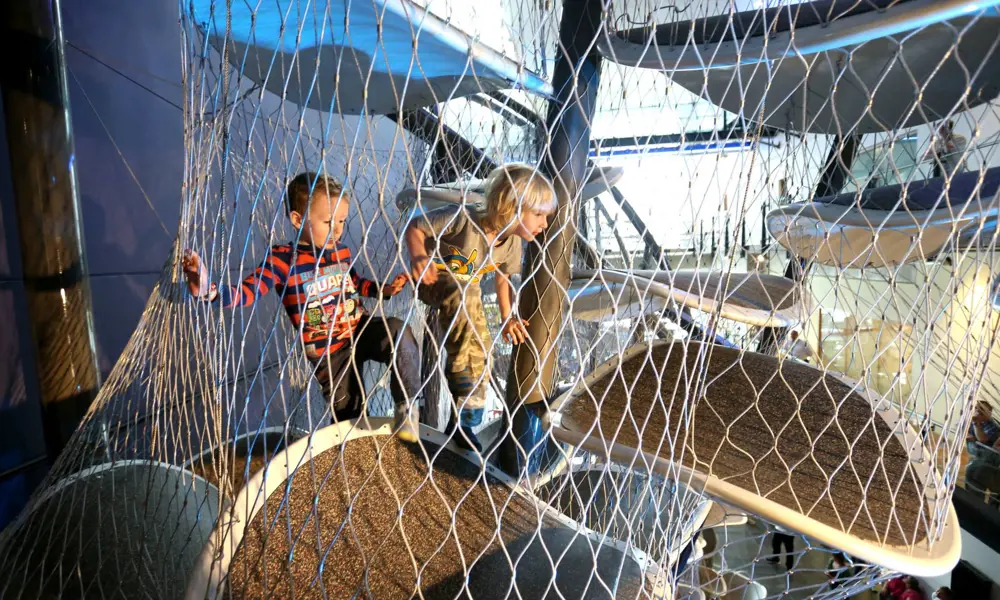
An engineered adventure
Did you know?
🪀 Playgrounds: not just for fun, apparently
- Playgrounds were created as long ago as the 19th century, when psychologists introduced them to help children learn about fair play and manners
- The first purpose-built, public access playground was opened in Manchester in 1859
- Play areas and playgrounds help children to problem-solve, think independently and develop their fine motor skills
Children’s play areas today have come a long way from a set of swings, roundabout, slide, and a seesaw. Play specialists, designers and engineers are almost turning play areas into works of art, making sure that their creations not only provide physical challenge and help children develop their motor skills, but also inspire their imagination and take them on an adventure.
US-based Luckey Climbers, which creates climbing structures that aim to encourage children’s development through problem-solving, spatial thinking, balance, social interaction, and cooperation, transformed the atrium of Belfast’s W5 science centre. When the centre opened, its four-storey atrium lay empty and didn’t reflect the inquisitive nature of the centre’s name (an abbreviation of ‘Who, What, Where, When, Why?’), or mirror the numerous interactive child-centric exhibits surrounding the space. W5’s developer, Dr Sally Montgomery OBE, approached the company to design and build a structure to fill the atrium, and provide an activity hub for children.
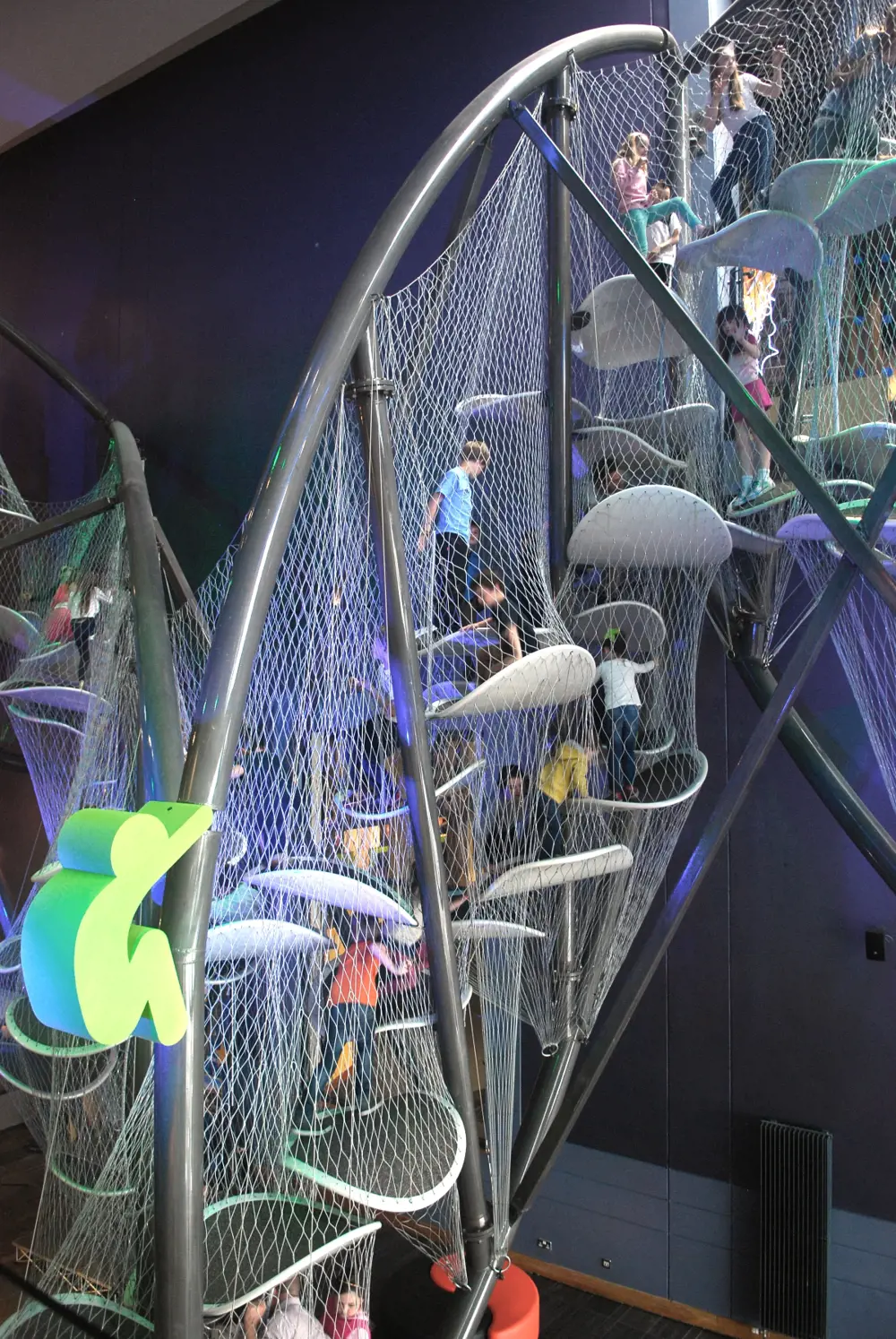
The result, Climbit, is a zig-zagging steel structure holding 99 climbable platforms suspended in wire mesh that creates a three-dimensional maze. The structure, inspired by the myth of the Celtic dragon, was designed to sync with the building’s interior, stretching between columns and beams in the walls and floor. Up to 70 children at a time aged between 3 and 16 can enter at the bottom and navigate freely between platforms that are never more than 45 centimetres higher or lower than their immediate neighbours.
“Early on, I decided the best outcome at W5 would be to make no modifications to the building whatsoever,” explains Luckey Climber’s owner Spencer Luckey. “Part of the mandate of the project was that it had to have a certain number of exits, so the finished layout had an inevitability to it.”
The concept evolved from the design needing an exit on each floor. “It was born out of a desire to not have a complicated interface with the building,” says Spencer. “There are three safety exits and one entrance proper that everyone uses. There is an exit on the third-floor catwalk, another one in the middle by a balcony that pokes into the space, and a third one on the bridge over the ‘head of the dragon’.” The exits are largely unnoticed by Climbit’s young explorers, who are concentrating on problem-solving their way along the various paths open to them – boosting their motor skills, physical agility and powers of concentration in the process.
Bringing Climbit to life
💡 Lights, camera, action!
Spencer and the team of designers carefully considered the lighting surrounding Climbit, ensuring that it enhanced its appearance as an interactive art installation. The sculpture is uplit and purple and white light pick out the reflective underside of each platform, causing them to shimmer. The uplighting was also designed to pick up children’s shadows as they explore inside and cast shadows onto the walls of the atrium to create a range of changing shapes.
As the W5 centre is located in Belfast’s historic dockyard and just across the river from the Titanic Museum, the lighting design also uses several water-themed elements. Projectors shine ‘ripples of water’ across the atrium, create an underwater illusion when paired with the shadows from the climbing children.
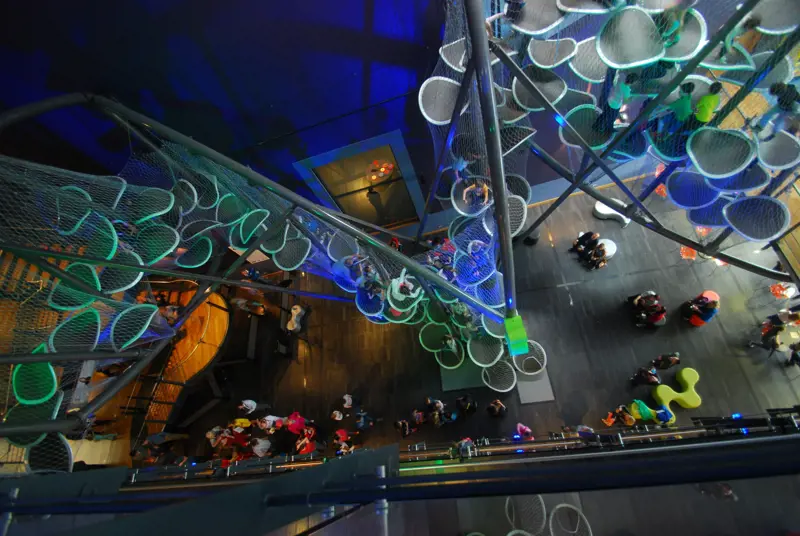
A view from above shows how Climbit fills the atrium and how the lighting design complements its appearance
Floating platforms
Climbit’s free-floating appearance disguises decades of engineering knowledge, starting with the construction of the individual platforms. They have been vacuum pressed to bond four sheets of 10-millimetre plywood together, then trimmed to produce smooth rounded edges; there are no sharp surfaces anywhere inside the installation. Platforms are coated in an extra skin of poplar veneer to enhance their rigidity, sprayed with iridescent car paint to reflect the installation’s dynamic integrated lighting (see ‘Bringing the climber to life’), and topped with a grippy layer of eco-surface rubber flooring.
The structure consists of a robust tubular steel frame and plastic-encapsulated steel cable mesh, which criss-cross the atrium and combine to suspend and enclose the platforms. The steel wires are 4.7 millimetres in diameter and are anchored to the top and bottom of every platform. The intricate net prevents the platforms from moving – even under their maximum live load of 1.26 kilograms per square metre. Alongside these uncoated steel structural cables are lengths of vinyl-coated wire rope, which has been fed through drilled holes dotted 10 centimetres apart along each platforms’ circumference to create a pattern.
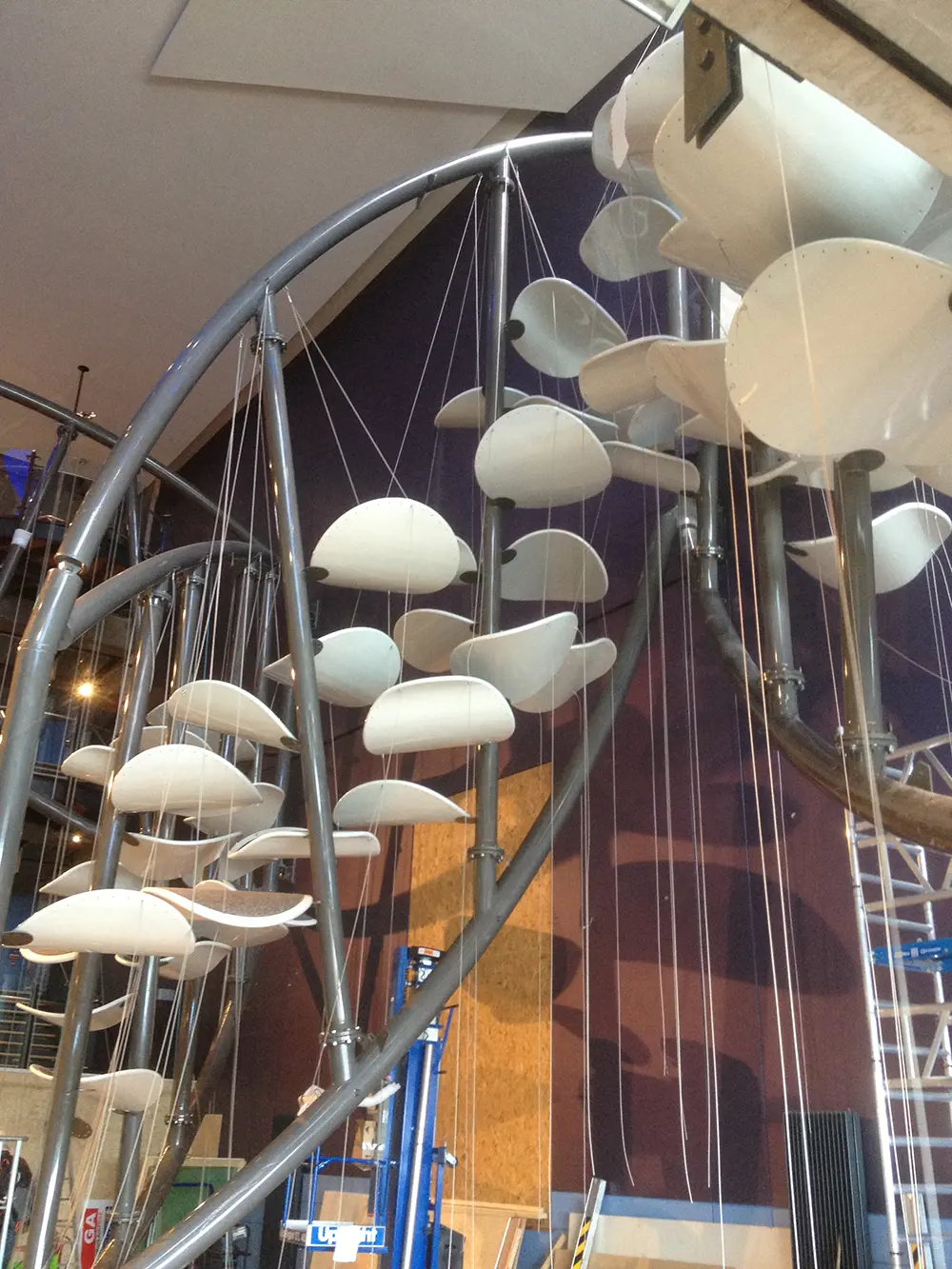
As well as being supported by wire mesh (which is yet to be added in this image while the structure was under construction),Climbit’s platforms are held in place with wire rope
“The vinyl rope was weaved on-site by hand, and it looks like it’s one continuous fishnet fabric,” says Spencer. He explains that the wire supports a maximum weight of 160 kilograms on each platform: “The breaking strength of one of those vinyl-coated wire ropes is 545 kilograms, and with between 12 and 25 ropes going through every platform, it’s incredibly strong. The larger cables have a different kind of fitting and are meant to carry a lot of the load, but it’s the friction that builds up on the edge from the vinyl-coated mesh that really makes it so secure, stitching it all up like shrink-wrapping.”
Working in tandem, the mesh prevents the platforms from rotating horizontally, while the cabling supports them vertically. “The platforms became much more stable once all the mesh was added,” Spencer adds. “It’s an integral part of the system that makes the whole thing feel static and safe. It’s important that kids go in there and don’t feel like they’re on something that’s moving, because I want to instil confidence in them to progress higher. It’s also much stronger – if you have a lot of moving bodies wiggling around, things tend to fall apart!”
The wire rope also serves another purpose: encasing each platform and ensuring it’s impossible for children to fall. Even 15 metres in the air, they’re cocooned on each level, able to freely move to other platforms but unable to stray beyond the various routes engineered into the design. “The routes that the children take inside has an inherent logic to it, like a staircase,” says Spencer. “You share the same space and circulation is dictated by the placement of the platforms. The layout is designed so that children won’t fall multiple times, with short distances between the platforms.” Children can only climb down one level at a time, while limited headroom means they are on their hands and knees most of the time, further reducing the risk of falling.
Modular construction
Spencer acknowledges that digital design software has made the process of designing a new installation far easier than when the company was founded by his father in 1985. “When my father started this company, he would imagine something and then do drawings before making a model. The model would take up a lot of the process time compared to the designing part. Using computer modelling, you can iterate and iterate, frontloading the process by designing until it’s time to manufacture without having to commit to any given geometry. You can constantly tweak a layout, which is a central part of how things are designed these days. It really benefits the built environment because we can build more complicated designs. For example, at W5, we didn’t have to mock the entire thing up prior to constructing it on-site, because we knew precisely what the geometry was.”
Inspiring playgrounds
🧶 Would you climb on a giant heron? Or a hand crocheted 3D sculpture?
Playground designers and engineers are taking inspiration from art when creating play spaces, and sometimes art itself becomes the playground. The Tate Modern’s Turbine Hall often plays host to interactive, child-friendly exhibitions, including Rasheed Araeen’s Zero to Infinity in summer 2023. Visitors of all ages were encouraged to use the exhibition’s 400 brightly coloured cubes to stack, tilt, balance, and rearrange to create an infinite number of different structures. In another example of art as the play area, artist Toshiko MacAdam began creating crocheted playgrounds after seeing children climbing in a three-dimensional textured sculpture that she was exhibiting. Her texture playgrounds use thousands of tonnes of nylon, which is knotted almost entirely by hand, and allow children to explore and take risks in a safe environment.
Danish company MONSTRUM’s playgrounds aim to become landmarks in their local areas – from giant otters on the Memphis riverside and seven-metre-tall herons in Tulsa that double as slides, to a 10-towered fairytale castle connected by gangways and bridges in north east England. Made up of craftspeople, designers and architects, the company focuses on using sustainably sourced wood and stainless steel in its designs.
Another company focusing on sustainability is London-based Adventure Playground Engineers, which works with local communities to develop play spaces that encompass natural features into their design, either building around or incorporate existing trees into play structures. It also recycles and reuses lots of different materials such as old boats, reclaimed timber and reconditioned slides. Its structures at Tumbling Bay Playground in the Queen Elizabeth Olympic Park features nests built from branches that have been weaved around oak trees.
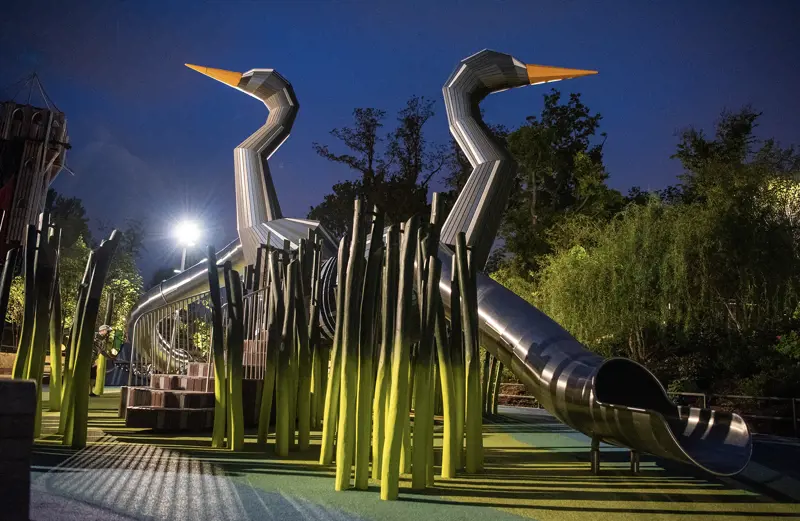
MONSTRUM’s Gathering Place playground on the riverside in Tulsa, Oklahoma. The heron’s ‘wings’ are slides that are almost four metres high © MONSTRUM
Having built a computer-generated model, Spencer’s team of installers then travelled to Belfast, along with the numerous individual components, which were shipped over in two containers from Connecticut in the US. Once in Belfast, the components had to be passed in through the window via crane and the atrium was filled with scaffolding to assemble the steel structure. “We prefabricated all the steel in our own studio, and then we used the computer to locate all the tabs that connect the platforms to the steel pipes,” says Spencer. “We assembled the design in the computer, which gave us a virtual mock-up and ensures the tabs are located very precisely.”
The result is an extremely rigid structure that can last for years without any attention: “Our products have been very well stress tested. Kids have notoriously prying fingers and they’re hard on stuff, so we take quality control and overall toughness very seriously. Every decision we make is based in some way on trying to provide the strongest solution.”
Climbit is one of over 80 structures built by Spencer’s team across the US, Europe and Asia – and the centre’s focus on avoiding simplicity means that it remains one of Spencer’s favourites: “The best projects we’ve done are the ones where the client was very demanding. Great clients make great projects.”
Contributors
Spencer Luckey is a US artist and kid architect whose firm, Luckey LLC, designs and builds climbing sculptures for institutional and commercial clients all over the world. A graduate of the Yale School of Architecture, Spencer seeks to design things that make people feel good about themselves and to foster social connections through shared experience.
Neil Cumins
Author
Keep up-to-date with Ingenia for free
SubscribeRelated content
Sports & leisure

Noise-cancelling headphones
Used by plane and train passengers wanting to listen to radio, music or film without hearing background noises, active noise-cancelling (ANC) headphones are able to prevent outside noise from leaking through to the inside of headphones.
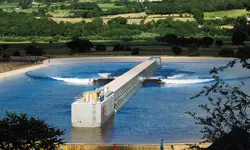
How to create the perfect wave
From small waves lapping at your feet and swells suitable for surfing to storm waves for testing structures and even tsunamis, waves of any shape and any size can now be engineered. What are the techniques and conditions needed to model waves and what makes some more powerful than others?

Going for gold
The success of Great Britain’s cycling team at the 2016 Rio Summer Olympic Games was celebrated, but what about the closely guarded technology that contributed to their success? The engineering approaches taken to shave as much time as possible off the clock are spoken about by Professor Tony Purnell.

A formula for success
Over the past 30 years, Paddy Lowe FREng has seen Formula One motor racing grow from small teams to a billion pound enterprise at the forefront of technology. He has introduced active suspension, hybrid engines and other key technologies that have changed the profile of motor racing.
Other content from Ingenia
Quick read

- Environment & sustainability
- Opinion
A young engineer’s perspective on the good, the bad and the ugly of COP27

- Environment & sustainability
- Issue 95
How do we pay for net zero technologies?
Quick read

- Transport
- Mechanical
- How I got here
Electrifying trains and STEMAZING outreach

- Civil & structural
- Environment & sustainability
- Issue 95